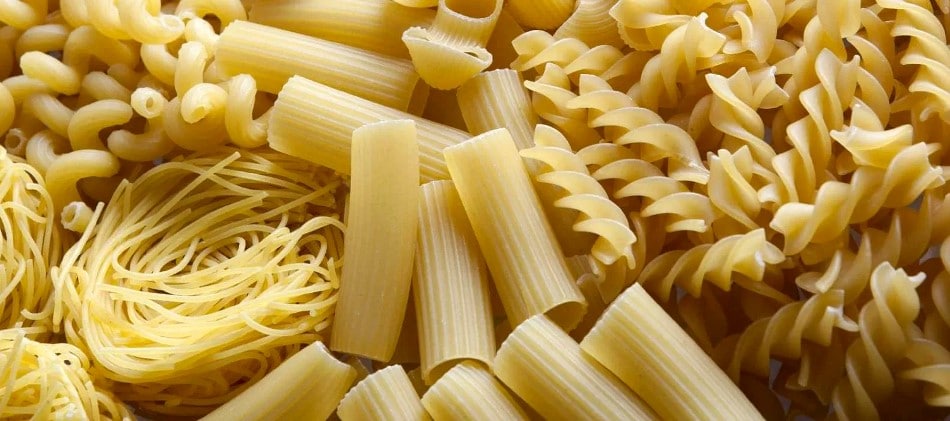
Pasta : Pasta is food made from a kneaded mixture of all-purpose flour, semolina de durum wheat,spelled, buckwheat (buckwheat) Of rice or other types of cereals, water and sometimesœuf as well as salt. "Pasta" can also refer to dishes where pasta is the main ingredient, served with sauce or seasonings. They present several varieties, according to the diversity of the forms like the shells, macaroni, noodles, penne, spaghetti ou noodles.
In Asia, pasta is also made with soft wheat flour, rice, sticky rice, mung bean (green soybeans), Yam, etc.
Beyond the simple condiments, added to the basic preparation, mix pasty initial, ancient European culinary traditions also mix various adjuvants: Herbs fresh, potato (gnocchi), etc. Recent research has validated the addition of legumes in quantities close to a third.
See Noodles ; Chinese noodles ; Rice noodles.
Types of pasta : The different types of classic pasta and specialties: pasta is distinguished by the nature and proportion of its components:
- Classic pasta
- Pasta with milk
- Egg pasta
- Vegetable or flavored pasta
- Gluten pasta
- Stuffed pasta
- Whole wheat pasta
Pasta families : We can classify pasta, most of which originate in Italy, into four main families:
- Soup or broth pasta
- Pasta to cook
- Pasta to gratinate or bake in the oven
- Stuffing dough
Use and cooking of pasta : The recommended amount of water for cooking pasta is one liter for one hundred grams of pasta. This proportion makes it possible to avoid cooling the water in the baking after adding the pasta and to avoid too high a proportion ofstarch in the cooking water. L'starch that ends up in the cooking water is responsible for the pasta that sticks together.
Pasta can only be cooked in boiling water and over high heat. They should be stirred during cooking to prevent sticking. According to a stubborn belief, a drop ofolive oil in the cooking water would prevent the pasta from sticking together. This is perfectly unnecessary since the oil does not mix with water, even boiling. However, an olive oil will subtly flavor the cooking water and thereby the pasta. On the other hand, when draining, the film of very hot and therefore very fluid oil, which will be deposited on the pasta, will be able to prevent them from sticking together by cooling in the serving dish. This is of no use in the case of an Italian preparation where most often the drained pasta is directly thrown into the pan where the filling is cooked and mixed with it. The real use of a little oil in the cooking water is, in thinning the starch which thickens the mousse boiling point, to limit the risk of overflowing. This is easily seen by pouring in the oil just as the boil begins to rise.
Pasta does not rinse after cooking. This would have the effect of cool, and above all to remove a quantity of starch essential for the Liaison accompaniment giving them a specific texture.
Although it is applied in industrial kitchens, pasta does not precook itself. This operation requires rinsing, which removes the quantity of starch necessary for the binding of their accompaniment and modifies its texture.
When the pasta is halfway through cooking, it can be transferred to a stove or an jig in which is the accompaniment and sautéed over high heat. Add the cooking water to the pasta to finish cooking them and loosen. This step makes the difference to obtain pasta tasty (who were able to take the taste of their accompaniment), and a sauce slightly linked (with thestarch contained in the cooking water).
The great chefs estimate that the cooking time al dente is 10% less than the usual cooking time.
- Cacio et pepe (Italian cuisine)
- Cannelloni (pasta)
- Cappelletti (pasta)
- Carrettiera alla (Italian cuisine)
- Casarecce (Italian cuisine)
- Cavatappi (Italian cuisine)
- cavatelli
- Cavatelli al cartoccio
- Angel's hair
- Conchigliette (Italian cuisine)
- Coquillette (dough)
- Cornette (dough)
- Corzetti (Italian cuisine)
- Crouzet (dough)
- Crudaiola (alla) (Italian cuisine)
- Cūmiàn (Chinese cuisine)
- Pansotti (Italian cuisine)
- Papiri (Italian pasta)
- Pappardelle (pasta)
- Pastítsio (Greek cuisine)
- Alphabet paste
- Pasta to gratinate or bake in the oven
- Soup pasta
- Pasta
- Pasta - General information on pasta
- Pasta - List of pasta and illustrated pasta board
- Classic pasta
- Penne (pasta)
- Pennoni (pasta)
- Pici (Italian cuisine)
